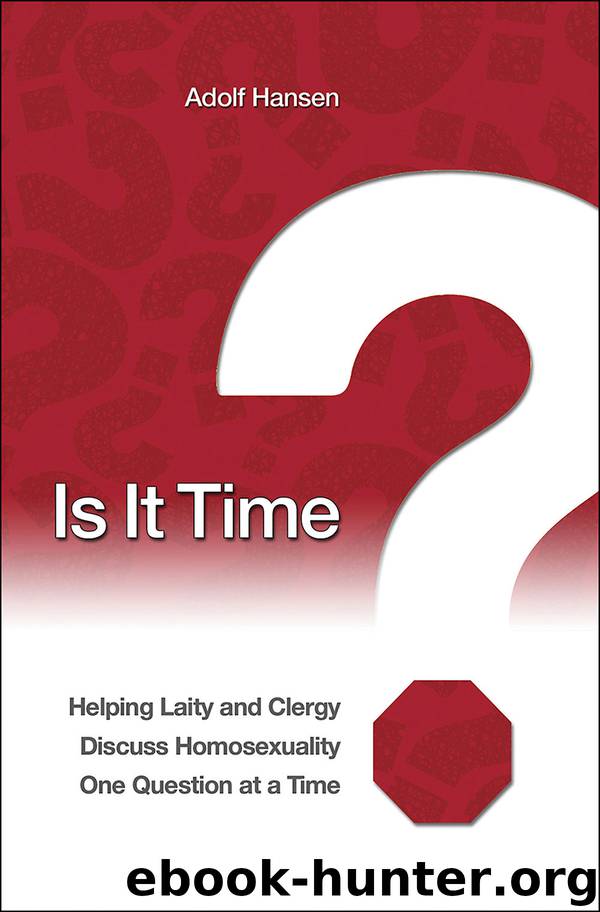Is It Time? by Hansen Adolf;

Author:Hansen, Adolf;
Language: eng
Format: epub
Publisher: Abingdon Press
Published: 2017-04-14T16:00:00+00:00
(pause to reflect)
Many laws in Leviticus are negative, explaining what should not be done (e.g., in 11:2-47 and other passages): eating shellfish such as shrimp, insects, birds, and animals of various kinds; wearing two types of fabric; sowing two kinds of seed in the same field; tattooing; etc. However, some laws are positive, expressing what should be done (e.g., in 19:18—loving your neighbor as yourself). Was the writer in this particular verse setting forth a universal or transcultural understanding when he identified such an expression of love, rather than referring to a way of life that was only meant to be local and temporal?
Passages related to same-sex behavior are also few and far between in the New Testament. Hebrew has no word that is equivalent to our English word homosexual; neither does Greek. In the 1946 New Testament edition of the Revised Standard Version, homosexual was used to translate two words, malakos and arsenokoites, as if they were one word in 1 Corinthians 6:9. However, realizing that such a translation was inaccurate—drawing a conclusion not warranted by the Greek text—the translation committee dropped homosexual and replaced it with sexual perverts in its next edition in 1971. The use of the word homosexual in this and other passages in the New Testament is not a precise rendering of any Greek word. Translations that use it are reading a point of view into the text that is not explicitly there—what scholars call eisegesis (reading meaning into the text) rather than exegesis (reading meaning out of the text).
Several nonbiblical authors in the first century—Seneca, Plutarch, Dio Chrysostom, Philo, and others—describe various beliefs and practices of Greco-Roman culture. Included as a part of these experiences of same-sex behavior are: (1) sex between adult men and young boys or older youth, (2) male prostitution, (3) sex between masters and slaves, (4) rape, and (5) promiscuous sexual episodes. All of these were rampant in that society, especially in large urban areas such as Corinth and Rome.
According to those ancient writers, one of the more common practices was sex between men and boys or youth. It is called pederasty, and the adult man is known as a pederast. Sometimes these encounters involved a coming of age ritual; at other times they were for pleasure. On occasion, money or other favors were given. Coercion was not uncommon, particularly when the boy or youth was a slave or the son of a slave. Such practices—widespread in the world of the first century—represent behaviors that are unacceptable to us today.
Download
This site does not store any files on its server. We only index and link to content provided by other sites. Please contact the content providers to delete copyright contents if any and email us, we'll remove relevant links or contents immediately.
| African-American Studies | Asian American Studies |
| Disabled | Ethnic Studies |
| Hispanic American Studies | LGBT |
| Minority Studies | Native American Studies |
Cecilia; Or, Memoirs of an Heiress — Volume 1 by Fanny Burney(32440)
Cecilia; Or, Memoirs of an Heiress — Volume 2 by Fanny Burney(31875)
Cecilia; Or, Memoirs of an Heiress — Volume 3 by Fanny Burney(31858)
The Great Music City by Andrea Baker(31539)
We're Going to Need More Wine by Gabrielle Union(18973)
All the Missing Girls by Megan Miranda(15598)
Pimp by Iceberg Slim(14399)
Bombshells: Glamour Girls of a Lifetime by Sullivan Steve(13979)
Talking to Strangers by Malcolm Gladwell(13233)
Norse Mythology by Gaiman Neil(13216)
Fifty Shades Freed by E L James(13163)
For the Love of Europe by Rick Steves(13116)
Mindhunter: Inside the FBI's Elite Serial Crime Unit by John E. Douglas & Mark Olshaker(9209)
Crazy Rich Asians by Kevin Kwan(9174)
The Lost Art of Listening by Michael P. Nichols(7412)
Enlightenment Now: The Case for Reason, Science, Humanism, and Progress by Steven Pinker(7242)
The Four Agreements by Don Miguel Ruiz(6641)
Bad Blood by John Carreyrou(6558)
Weapons of Math Destruction by Cathy O'Neil(6152)
